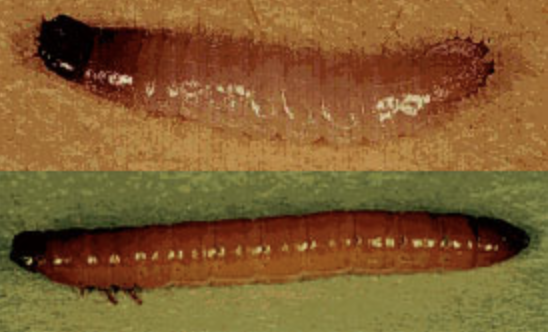Editor’s Note: Whatcom Watch has entered a cooperative agreement with Salish Current. When possible, we will share each other’s content. Salish Current, an online-only news organization, covers the North Sound area and Whatcom Watch mainly covers Whatcom County issues. This article is an exception. Visit https://salish-current.org.
by Kai Uyehara
Part 2
A Moving Target
Wireworms are hard to eliminate, so managing damage is a moving target for many farmers.
No organically sourced insecticides have been found effective against wireworms, per WSU Extension research. Conventional agricultural farmers have more options, but they also suffer wireworm infestations, Brouwer said. In fact, phasing out carbamate, organophosphate and organochlorine insecticides for health and environmental reasons may have given wireworms room to thrive, WSU Extension researchers reported. (9)
Because of their relatively recent appearance in Northwest Washington, there isn’t much generational knowledge to share within the agricultural industry. Viva reached out to the WSU Northwest Research Center, which has been conducting wireworm surveys and management trials.
The farm center began teaching more about wireworms in their practicums for new growers, hosting wireworm workshops, sharing local research, having farmers inspect wireworms under microscopes and detailing ways to control infestations with organic methods.
Once a farmer identifies a wireworm infestation, “there’s not really one easy way to get rid of them, and trying to integrate as many different management strategies as you can to help manage them is all part of a puzzle,” Brouwer said.
Frequent tilling, particularly in early and late summer, can disrupt wireworms by creating a hostile habitat, Brouwer said. But this is time-consuming and can be detrimental to soil health. It’s a difficult tradeoff to make.
Mustard has been the only reliably successful wireworm deterrent that Christine Langley has found. When tilled before it blooms, mustard releases a toxin that kills wireworms.
“We’re really trying to figure out how to work the soil less as we organic farmers try to build organic matter,” Langley said. But “wireworms, they’re attracted to CO2, they’re attracted to decomposing organic matter. So all the things that you really don’t want to do, like till the soil or minimize the organic matter, those aren’t things that we want to do for all the other reasons.”
Fighting Back
Farmers also adapt their production away from more vulnerable plants like lettuce, opting for crops that can tolerate more damage. Some brassicas such as mustards and cabbages, produce a compound that acts as a repellent, Brouwer said, mentioning that he’s heard that buckwheat may be toxic to wireworms as well.
Not many management techniques have worked for Langley, but planting mustard near her lettuce and mowing it before it blooms seems to kill her wireworms. She also plants carrots, onions, squash and peas on areas of her farm where wireworms would destroy her lettuce because they don’t seem to bother these alternate crops.
Lawrence now grows her tomato plants larger before transplanting them, making them stronger against the feeding wireworms. She also employed trap cropping, a technique that baits wireworms away from prized produce with a dispensable crop. Lawrence buried potatoes, which were more attractive to the worms than tomatoes. She impaled them on a stick for easy removal. Then she pulled the bait from the ground and killed the pests with a knife.
In his research, Brouwer and his comrades studied trap cropping by planting wheat among lettuce and found the tactic effective, though it demands extra space and time in a farmer’s production system.
Langley tried that but found the tactic impractical. “I was planting a 100-foot row (about) every week and I just couldn’t see doing that on that scale,” Langley said. “Time is money if you’re having to hire people to do it with you.”
Because managing wireworms is so challenging and they can’t be eliminated, Smith advises diligent preparation before cultivating.
“It’s a lot of knowing how to precisely rotate your crops in a way that’s not setting yourself up for the wireworm,” Smith said. Larvae are deeper in the ground during hotter, colder or drier months, so Smith advises new farmers to plant susceptible crops when pressure from wireworms will be lowest and plant more resilient crops when the worms are active.
Langley grows lettuce earlier in the season to skirt high wireworm activity in the late season and avoids a section of her farm where the population is high. She’d planted sweet corn in the same area and saw it destroyed.
“If your farm is set up to grow a lot of wheat and then rotate with potatoes, but you need to switch to a different crop in your rotation, that can be a huge change,” Brouwer said. “It may not be something that there’s easy markets for.”
Taking the Long View
After Viva Farm alumni move on to their own new farms and face down wireworm infestations on their cultivated ground, Viva maintains relationships and offers resources. They encourage farmers to trap crop new land, to assess wireworm pressure in the area, to inquire about the plot’s tillage history and to engage with local Extension offices.
“You’re never going to eliminate the population,” Langley said. “You just want to sort of suppress it for a little while.”
Langley converses with neighboring farmers yearly about wireworms and finds surprising differences in the crops their infestations do or don’t affect, and the techniques that work for one farm but not another.
“I feel like there are way more questions than there are answers,” she said.
______________________
Kai Uyehara (he/him/his) is freelance reporter for Salish Current and a recent graduate from Western Washington University. He graduated with a major in English creative writing and a minor in news/editorial journalism. He is originally from Glenwood Springs, a small town in Colorado. Kai is interested in reporting on stories concerning and intersecting with social issues





























